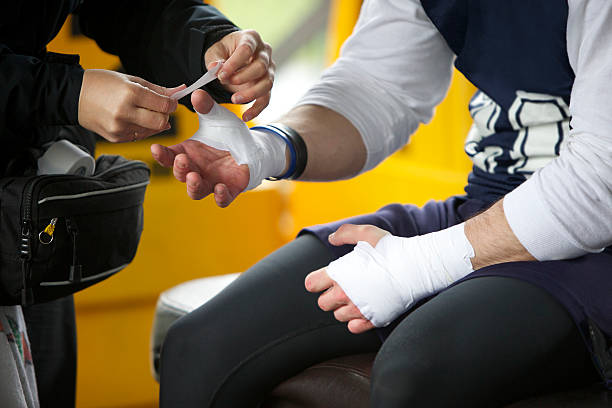A well-supported and stable wrist taping for rugby players can significantly enhance their performance on the field.
As a rugby enthusiast, I’ve seen lots of Rugby players practice on fields from Twickenham Stadium to Eden Park.
You will always notice that most of the players tape their wrists and it is a reason!
Primary Reasons of Wrist Taping for Rugby Players

Rugby is a tough sport, and players like Jonny Wilkinson know the importance of wrist protection.
Wrist taping serves three main purposes:
1. Prevent Wrist Injury
2. Support and stability
3. Protection during tackles and impacts
Think about it: the rugby player’s wrists take a bit of a beating in rugby.
From diving into a tackle to passing the ball down the line, to reaching out for a high pass, the wrists are always moving and always under stress.
Every play, from those hard-hitting tackles to precise ball handling, requires strength and stability in your wrists.
Such constant strain, if you’re not supported properly as with wrist taping-could lead to injury, keeping you off the field.
This is why protection of the wrists in such a physically demanding sport like rugby is very important.
Benefits of Wrist Taping for Rugby Players
The benefits of wrist taping go beyond just protection.
Let’s break it down:
Improved Grip Strength
Proper wrist taping for rugby players can enhance a player’s grip on the ball.
This can be crucial in wet conditions or during intense scrums.
Sprains and Strains Prevention
Wrist taping for rugby players works by not allowing the wrist to over-move in any direction-particularly because, when your wrist bends too far, injury can occur.
Limiting how much your wrist can bend helps protect it from over-stretching, which results in painful strains or sprains.
This additional support makes a huge difference in diminishing the chances of injury during any game.
Psychological Confidence Boost
The mental approach is as important as the physical.
By knowing your wrists are adequately supported with taping, it can give the player a strong sense of added confidence.
You just feel more secure and less apprehensive about injury, which can make you play with more courage.
You can take that little extra assurance and try harder moves, go for that play that is a little riskier, or you can simply feel more comfortable pushing the limits of your game with that added layer of protection.
Safety can help you to focus better, meaning playing better.
Types of Tape and Taping Techniques
Athletic Tape
Athletic tape is the more traditional resistant tape used in sporting activities.
It’s designed to support well and limit movements at joints such as the wrist or ankle.
In effect, what it aims to do is avoid injuries such as sprains or strains is cause a reduction of excessive movements.
This allows little flexibility; hence, it usually goes on tight to keep joints stable in high-activity, contact sports like rugby.
Kinesiology Tape
Kinesiology tape is an athletic tape that is much more flexible and stretchy. It fosters more mobilization, which in turn offers light support to the individual.
Many people use kinesiology tape to assist in muscle recovery and to improve circulation, all while offering light support without restricting one’s movements.
Rather, it is seen in many athletes who are recovering either from minor injuries or trying to avoid instances of muscle fatigue while still being able to maintain flexibility.
Common Taping Methods for Rugby Players
Common method of wrist taping for rugby players involve taping the wrists in a plethora of manners that suit individual needs over both support and flexibility.
- Light Support Wrap: This is a simple wrap around the wrist, allowing for mobilization.
- Figure-eight technique: Wraps figure-eight over the wrist and hand for added stability.
- Anchor and Loop: A tape wrapped around the wrist, having loops running up the thumb to provide maximal support.
- Half-Hand Wrap: Encompasses the wrist and a portion of the hand for a more secure grip.
- Thumb Spica: Additional support to the thumb and wrist, primarily for those players prone to thumb injuries.
Potential Drawbacks and Considerations
While wrist taping offers numerous benefits, it’s not without its potential drawbacks. Let’s take a balanced look:
Restricted Movement
Taping too tightly can limit wrist mobility, potentially affecting your performance. It’s a delicate balance between protection and flexibility – something Dan Carter likely mastered during his career.
Skin Irritation and Allergies
Some players may experience skin irritation or allergic reactions to the adhesive in the tape. It’s essential to test for any sensitivities before a big match at Eden Park or any other venue.
Dependency Concerns
Overreliance on wrist taping could potentially weaken the wrists over time. It’s important to combine taping with proper strength training for long-term wrist health.
Alternative Wrist Protection Methods

Taping isn’t the only way to protect your wrists in rugby. Let’s explore some alternatives:
Wrist Guards and Braces
Some players opt for wrist guards or braces instead of or in addition to taping. These can offer more rigid support but may feel bulkier during play.
Strengthening Exercises for Wrist Stability
Prevention is better than cure. Incorporating wrist-strengthening exercises into your training routine can help build natural stability and reduce reliance on external support.
Conclusion
Wrist taping also provides extra support during tackles, enabling players to hold onto the ball better, hence acting as a safety measure that has greatly improved the game of rugby players.
It is not a habit or tradition but one important safety measure in preventing players from getting injuries that help improve their game.
This is not a lifestyle decision per se; rather, this is heavily implemented from major organizations down, such as World Rugby and the Rugby Football Union, as part of their player safety policy.
This is another portion of how modern rugby players maintain safety and perform at their best.
If you’re considering incorporating wrist taping into your rugby routine, it’s essential to learn proper techniques. Consult with experienced trainers or physiotherapists to find the best taping method for your needs.
If you found this blog helpful, be sure to explore more of our related content for additional insights and information on similar topics.